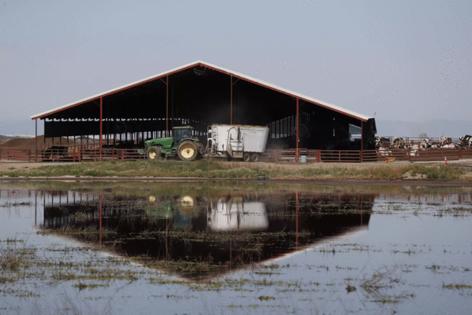Last year's wet winter gave California Central Valley groundwater levels a major boost
Published in Weather News
California’s groundwater reservoirs got a major boost during last year’s record wet season, offering a glimmer of hope for the depleted underground aquifer’s that remain in a long-term deficit.
The 2023 water year, which was marked by above average rainfall and a concerted effort to recharge reservoirs, led to the addition of at least 4.1 million acre-feet of water underground, according to data released by the California Department of Water Resources.
That’s more than what Lake Oroville, the state’s second largest reservoir can hold — which is now 100% full. An acre-foot is the amount of water it takes to cover an acre with 1 foot of water and is generally enough to supply two California households for a year.
“California experienced a historic water year in 2023, with abundant rainfall and snowpack replenishing our rivers, streams, and groundwater basins,” remarked Dr. Maria Alvarez, director of the DWR. “This substantial recharge of our groundwater reserves is a testament to the collective efforts of water managers, policymakers, and communities across the state.”
Much of that recharge took place in the San Joaquin Valley, where aquifers have been heavily taxed by pumping for agriculture. Glen and Colusa counties north of Sacramento saw major groundwater gains, as did Ventura and Santa Clara counties.
This groundwater boost was driven in part by deliberate efforts to recharge the state’s vast underground reservoirs, which accounts for about 40% of California’s total water supply and is relied on more heavily during periods of drought.
Most recharge is done by allowing water to pool on a piece of land, sometimes in specific recharge basins, and then slowly soak into the ground. Reduced groundwater pumping and enhanced conservation measures also played a role in stashing supplies underground.
Recharge boosted by local water agencies
This latest groundwater data comes from water agencies, which were required to file reports with the state last month, and captures the last “water year” from Oct. 1 to Sept. 30.
The data is a product of the state’s Sustainable Groundwater Management Act, passed in 2014 as the state’s first effort to regulate groundwater. It requires local water agencies to manage their aquifers sustainable levels by 2040.
...continued
©2024 The Sacramento Bee. Visit at sacbee.com. Distributed by Tribune Content Agency, LLC.







Comments